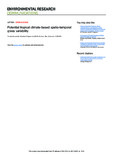Potential tropical climate-based spatio-temporal grass variability
Date
2019-03-15Author
Kigen, Charles K
Muyekho, Francis N
Masibayi, Edward N
Makindi, Stanley M
Metadata
Show full item recordAbstract
Numerous international agreements aimed at reduction of greenhouse gas emissions by signatory countries have been ratified in an attempt to combat the adverse varied impacts of climate change and promote resource use sustainability. Grass is an important resource that livestock, wildlife and human beings depend on and is largely influenced by climatic conditions. The grass in Kenya supports the key economic activities of livestock and wildlife-based tourism. This significant contribution to gross domestic product underscored the need to model the impacts of climate change on the grass for the country to promote sustainable development. The study aimed at modelling the impacts of projected climate variations on the spatial and temporal distribution of grass in the base-year (1950–2000) and the future climatic periods of the years 2050 and 2070. The spatial data was sourced from United States Geological Survey, International Livestock Research Institute, and Africover Project processed and analysed in ArcGIS, DIVA-GIS, Maxent and Map Comparison Kit softwares. The models outputs were significant with the least area under receiver-operator curve (AUC) values of 0.754. The study found out that the 2050 climate will decrease grass niche suitability by 44.99%, the unsuitable will increase by 87.01%, the grass niche suitability location will shift by 76.7% and the category areas change by 46.4%; the 2070 climatic period grass niche suitability will shrink by 55.21%, the unsuitable category increase by 106.80%, the location change will be 77.8% and the category areas will vary by 66.0%. The research concluded that the rangeland vegetation (grass) will decline and shift location in the both future climatic periods.
URI
HTTPS://DOI.ORG/10.1088/2515-7620/ab0cc7/metahttps://iopscience.iop.org/article/10.1088/2515-7620/ab0cc7/meta
http://ir-library.mmust.ac.ke:8080/xmlui/handle/123456789/1833
Collections
- Gold Collection [1026]

